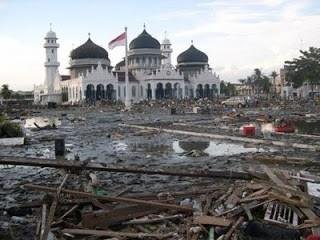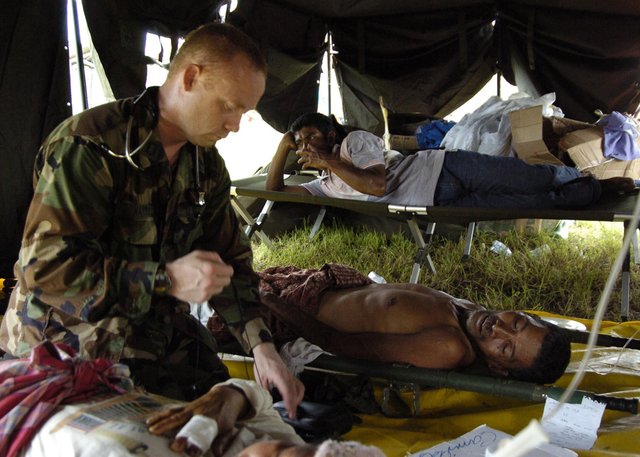

EARTHQUAKE 9.3 on the Richter scale on Sunday morning, December 26, 2004, followed by an upsurge in tsunami waves recorded as the most devastating disaster with the greatest death toll ever recorded. Based in Simeulue, the tsunami swept parts of Aceh, Malaysia, Thailand, India, Sri Lanka, to the east coast of Africa.
The United Nations noted that 229,826 people were missing and 186,983 people were killed in eight countries. In Indonesia, 126,000 people are reported killed. In Sri Lanka, 45,000 people are dying. In India, an estimated 12 thousand more victims. In the tourist area of Thailand, an estimated 4,500 people lost their lives. In addition, millions of people are homeless.
As the worst affected area, the world's attention is on Aceh. Hundreds of foreign institutions plunge and have offices in Banda Aceh. From humanitarian volunteers, foreign troops, journalists, world leaders, to celebrities such as Julia Robert and Jacky Chan to Aceh.
The TNI noted that up to the beginning of January 2005, 3,711 foreign troops from 11 countries were struggling to help tsunami victims. The Germans set up tents at the crippled Zainoel Abidin hospital. Australian troops evacuate corpses and treat Krueng Aceh water in downtown Banda Aceh into clean drinking water. The American Army brought the huge aircraft carrier Abraham Lincoln with equipment to treat the sick. So are soldiers from Singapore, Malaysia, Pakistan, Switzerland, France, Brunei Darussalam, and England, they work together with 45 thousand Indonesian troops.
The solidarity of the world, regardless of ethnicity and religion, has to be recognized, has pushed the process of rehabilitation and reconstruction of Aceh to run faster than expected. The UN even noted, Aceh's recovery after the disaster is much better than the handling of large-scale disasters in other countries.
For press workers like me, disasters - especially on a large scale - are news that should not be missed. Not surprisingly, the international media also spilled into Aceh. So, Aceh also the arrival of journalists and photographers of the world caliber like TIME magazine, CNN, BBC, Reuters, and others. They came with equipment that was even partly foreign to local journalists like me. There is no division of religion or belief. All unite in the name of humanity.
Two days after the tsunami, Banda Aceh, which had been isolated from the outside world on the first day of the disaster, began to decorate the television screen. The world was struck by the disaster mahadahsyat.
Still recorded clearly in my mind, the journalists covering the disaster reporting anjong mon eye, the building behind the governor's residence, as a gathering place. Among the anxieties of the aftershocks that came many times, they recorded, edited, and sent pictures and disaster stories to their respective offices via the internet and satellite connections. Anjong mon eye was changed like a miniature news agency where hundreds of journalists from various media "berkantor."
I was then working for Tempo, still sending reports to Jakarta while searching my uncle's body for a missing family. A few days later, I found my ma bit (aunt) dead body lying face down in a car in the Prada cemetery in Banda Aceh. They were hit by a wave when trying to save themselves from Lingke heading toward the city. Apparently that is not the right path to save yourself. Aided by a number of people, we then buried his body without bathing. Because it has been found a few days, the corpse has meruapkan aroma is not delicious. We tried to overcome it by sowing coffee powder. Innalillahi wainna ilaihi rajiun.
After burying the corpse, work as a journalist must continue. Tempo sends a team from Jakarta. I was touched when they brought me clothes, also the knick-knacks of everyday life. To work, I brought my only PC to the governor's pavilion. The computer was then used interchangeably with a number of other colleagues. My pocket camera was damaged by falling into the water as it ran to escape the raging waves of the sea that entered the city center. As a result, I was forced to produce only stories,
A week later, I met Andrew Marshall, a Bangkok-based TIME magazine reporter. Surprisingly, the British man came with a number of Canon 300D cameras and external hard disk that can be used to store data. Coordinating with Hotli Simanjuntak, then a photographer of the AFP French news agency in Banda Aceh, the cameras and hard disks were one by one distributed to local journalists who lost work equipment. I get one camera and one external hard disk. These two tools work complementarily. Once you have finished taking the picture, insert the memory card into the hard disk, then the photo is directly saved to the hard disk without the need to connect to the computer.
Still remembered when Andrew said, to get the money to buy the equipment, the community of journalists in Bangkok held a kind of race. The prize was then used to purchase work equipment for Acehnese journalists who lost their equipment.
"Do not value this item from the price, it is our solidarity to the journalists here," Andrew said as he handed me the aid.
I am moved. It is inconceivable that all of their efforts that I have not even met before do such a thing to help us, local journalists.
Armed with the camera and external harddisk help that I recorded images of the damage caused by the disaster and the recovery process of Aceh. Unfortunately, the camera has now been damaged when it fell off the motor. While the external hard disk still accompany me to work until now.
Remembering all that, I am reminded of an sms I received from a friend in Medan, North Sumatra, on the eve of the turn of the year from 2004 to 2005. "Happy New Year, may be protected by the Almighty," it read.
New Year? I gasped. That night, I was traveling around the city to mereportase the night atmosphere in Banda Aceh. I forgot, that night the year will change. How not, in the yard of the Grand Mosque, the dark atmosphere because electricity is not normal yet. The stench of a dead body still pierced the nose. In the courtyard of the mosque, the fire still burns wooden debris carried by the tsunami waves. The atmosphere is quiet. No fireworks or fireworks welcome the turn of the year. In some places, the corpse still lies in the difficulty of the evacuation process.
That is why, for me and other Acehnese people, the change of 2004 to 2005 is unforgettable for life.
That night, I replied to Rinaldi's sms like this, "Thank you. With your solidarity, Aceh will certainly be standing up again. "
Today, 10 years after the sms I sent, the solidarity - in the character of the Acehnese who did not give up - proved to have changed the face of Aceh: the streets were peeled into transparency with smooth streets, new villages emerging, schools International standard schools are also emerging. The old history that had been buried with the ocean waves created a new sheet. The world community, with diverse religious backgrounds and convictions helps to help Aceh.
In remembrance, in Blang Padang, Banda Aceh, there are now a number of inscriptions containing the names of aid-giving countries for Aceh. The park was named "Thanks to the World."
Nice
Downvoting a post can decrease pending rewards and make it less visible. Common reasons:
Submit